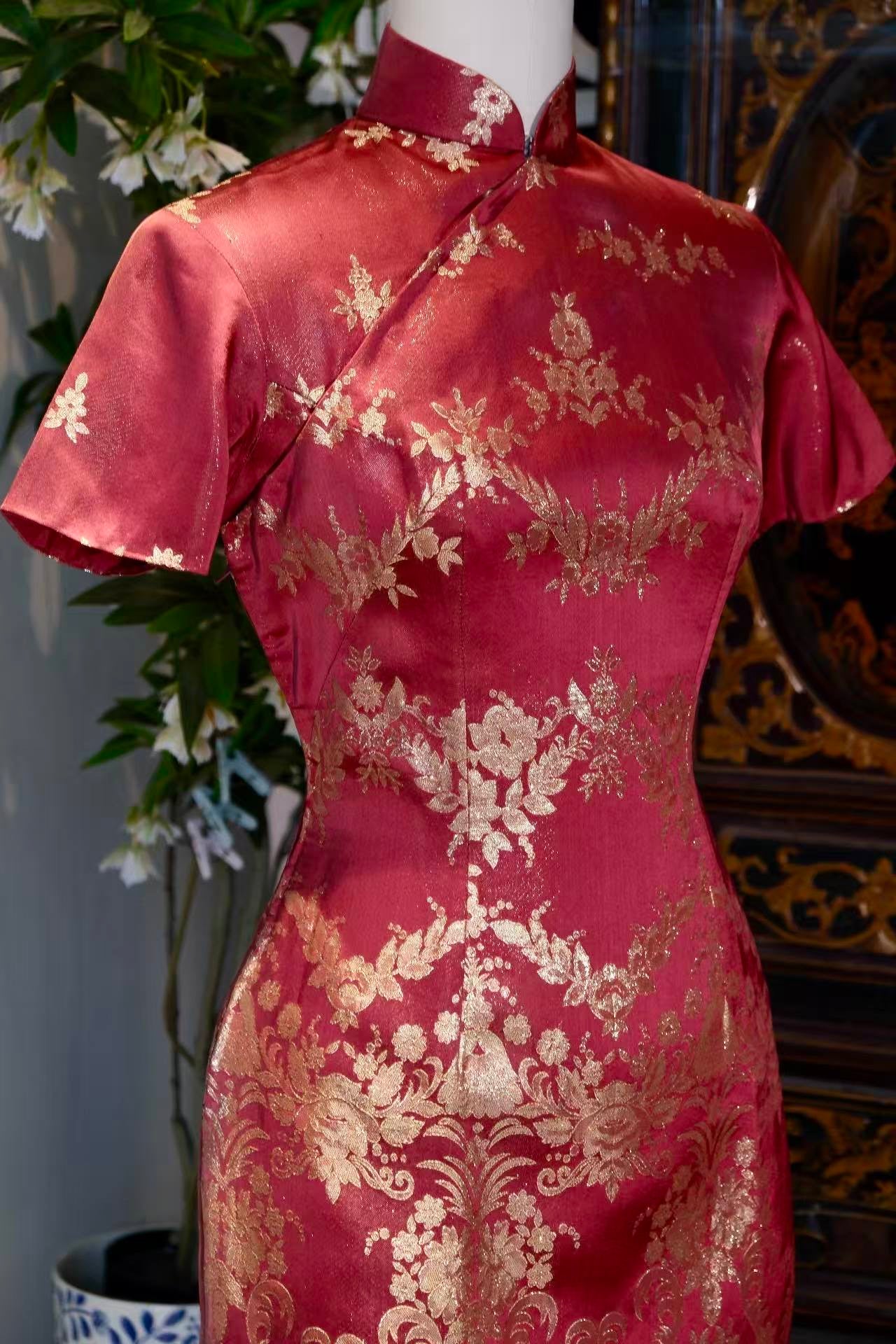深圳溯源
50年代 - 上世纪五十年代香港织金提花缎巴洛克旗袍 | 1950s - A Fifties Hong Kong Brocade Baroque Cheongsam (Qipao)
50年代 - 上世纪五十年代香港织金提花缎巴洛克旗袍 | 1950s - A Fifties Hong Kong Brocade Baroque Cheongsam (Qipao)
Couldn't load pickup availability
分享一件上世纪五十年代香港织金提花缎巴洛克旗袍的华美咏叹。
胭脂红缎面上,金线织就的巴洛克纹样如落日熔金,
旗袍通体以对称式团花布局,主体纹样分为胸背、腰腹两大核心区。
材质上,胭脂红缎面采用南京云锦的“妆花纱”工艺:纬线需预先“
历史背景中,1950年代的香港作为“东方好莱坞”,
古董旗袍多因保管不善而褪色脆化,
当聚光灯穿过岁月尘埃,这件旗袍上的金线仍如熔金流淌,
👑 A Grand Aria of Splendor: The 1950s Hong Kong Brocade Baroque Cheongsam
This antique cheongsam, born in the 1950s, captures the glamour of the era. The gold-threaded Baroque patterns woven onto the rouge-red (胭脂紅) satin resemble molten gold at sunset, crystallizing the dazzling style of Hong Kong cheongsams into a single, flowing damask painting. This garment uses the traditional Chinese brocade (織金提花) technique as its structure and fine metallic threads as its sinews, fusing the elaborate grandeur of Baroque art with the reserved elegance of traditional Chinese aesthetics. It stands as a half-century-old fashion specimen of East-West cultural fusion.
I. The Brocade Pattern: Baroque Dynamics in Oriental Silk
The entire cheongsam features a symmetrical "tuanhua" (團花 - clustered floral medallion) layout, with the main motifs divided into two core areas: the chest/back and the waist/abdomen.
-
Central Motif: On the chest and back, a six-petaled Baoxiang flower (寶相花 - Buddhist auspicious flower) blooms centrally. The edges of the petals feature Baroque-style volutes (渦卷狀), resembling the carved wall decorations in the Hall of Mirrors at Versailles.
-
Rococo Detail: The center of the flower is adorned with radiating gold threads, similar to the gilded patterns on a Rococo screen.
-
Dynamic Flow: Surrounding the Baoxiang flower, intertwining peonies (纏枝牡丹) and honeysuckle (忍冬紋) are woven together. The veins of the leaves are outlined with shimmering metallic threads, creating the illusion that a slight breeze would make the leaves flow with the movement of the gold threads.
-
Baroque Spirit: This "S"-shaped dynamic curve subtly echoes the rhythmic drapery folds in Bernini's sculpture, The Ecstasy of Saint Teresa, translating the Baroque core spirit of "rejecting stillness and embracing movement" into the rhythmic language of Oriental textiles.
II. Material and Craftsmanship: The Royal Touch
-
Material and Technique: The rouge-red satin utilizes the "Zhuanghua Sha" (妝花紗 - figured gauze) technique of Nanjing Yunjin (Cloud Brocade). This demanding process requires the weft threads to be "dug out and lifted through" (挖花提通) and woven using the "discontinuous weft" (通經斷緯) method. This precision causes the gold patterns to stand out from the red satin like relief sculptures.
-
Historical Echoes: This technique was primarily found in imperial textile manufacturing during the Qing Dynasty. The 1950s Hong Kong cheongsam's combination of this technique with the Western Baroque aesthetic is heralded as "the response of Oriental brocade artistry to Western magnificent aesthetics."
III. Historical Context: Fusion in "Oriental Hollywood"
The 1950s Hong Kong, often called the "Hollywood of the East," inherited the refinement of the "Haipai Qipao" (Shanghai-style cheongsam) while integrating the Baroque and Rococo revival trends brought by Western immigrants.
-
Silhouette: The "high-slit + short-sleeve" cut retains the sensual restraint of the Chinese cheongsam.
-
Luxurious Layout: However, the method of laying out the gold brocade medallions is clearly inspired by the lavish concept of "full-width jacquard" from Western haute couture. If the cheongsam were unfolded, the pattern layout would be identical to the "full-panel embroidery" found on 18th-century ladies' gowns at the Palace of Versailles. Yet, the addition of the Chinese Mandarin collar and frog fasteners adds a layer of "reserved assertiveness" (含蓄的張揚).
IV. Preservation and Legacy
-
Condition: While many antique cheongsams fade and become brittle due to poor preservation, this piece retains the vividness of the rouge-red and the luster of the gold threads, maintaining an excellent condition as if newly woven.
When the spotlight cuts through the dust of time, the gold threads on this cheongsam still flow like molten gold, singing a grand aria of an era's splendor on the red satin. It is not merely clothing but a "soft sculpture" encompassing the artistic genes of East and West. When the viewer gazes upon the intertwining peonies and scrollwork, one can almost hear the waltzes of 18th-century Versailles balls and the rattling looms in old Shanghai tailoring shops. The fleeting brilliance is condensed into the color of rouge—the magnificence of history is no more, and no less, than this.
Share







